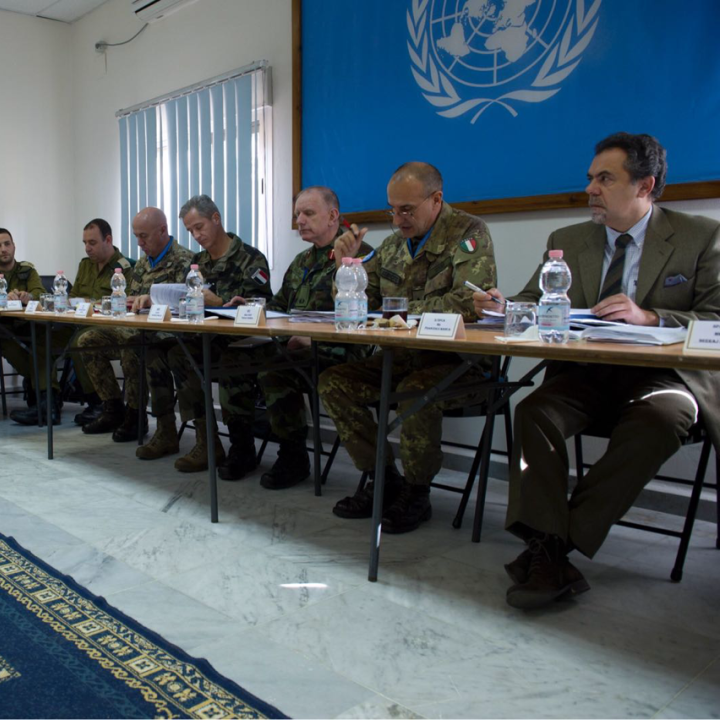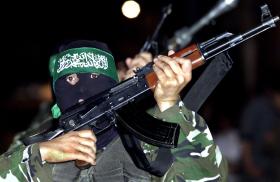
- Policy Analysis
- PolicyWatch 3963
Back to the Future in Lebanon? Ceasefire Lessons from 2006

The former head of Israel’s “tripartite” delegation reflects on the slow-rolling failures that followed the 2006 ceasefire—lessons that can help authorities overcome similar obstacles to the new agreement.
As in 2006, the main challenge for the new Lebanon ceasefire is not so much the wording of the agreement, but its actual implementation. When Israel’s previous war with Hezbollah ended in August of that year, a ceasefire was announced in accordance with UN Security Council Resolution 1701. Two days later, the Israel Defense Forces (IDF), the UN Interim Force in Lebanon (UNIFIL), and the Lebanese Armed Forces (LAF) held their first tripartite meeting to discuss implementation. As a member of the IDF delegation and later its head, I participated in managing postwar challenges until 2015. The experience of those years points to some of the obstacles ahead for the authorities tasked with implementing the new ceasefire—from ensuring accountability among the Lebanese government and army to defining the scope of Israeli efforts to prevent Hezbollah violations.
The Morning After
In the days immediately following the 2006 ceasefire, IDF units still in Lebanese territory encountered Hezbollah terrorists who had come out of hiding, resulting in fire incidents. Hezbollah members also infiltrated groups of Lebanese civilians returning to their homes, further complicating the situation.
In subsequent weeks, the IDF gradually withdrew to Israel in coordination with UNIFIL. The peacekeeping force then took control of those portions of southern Lebanon covered by Resolution 1701 before the LAF entered. The tripartite meetings served not only to coordinate the withdrawal, but also to establish communication between the parties on the ground. In addition, the IDF performed engineering work necessary to destroy enemy infrastructure and repair the border security barrier and other defenses—activities that Lebanese officials characterized as violations.
Longer-Term Results
The year following the 2006 war saw new rules of the game take shape. Initially, UNIFIL peacekeepers patrolled the south and discovered numerous Hezbollah military positions there. The IDF provided UNIFIL with information about additional locations, expecting them to be inspected and dismantled. Instead, UNIFIL gave the information to the LAF, which usually replied that the sites in question had been inspected “without findings” or that the assets were now the army’s responsibility. In those cases where LAF or UNIFIL personnel actually entered such sites, Hezbollah was given enough time to evacuate them first. The LAF ostensibly seized any stray weapons found there—only to hand them back to Hezbollah, as IDF intelligence showed.
In addition, UNIFIL checkpoints were not allowed to search vehicles even if they were suspected of conducting Hezbollah military activities. And at LAF checkpoints, Hezbollah members were reportedly permitted to present special IDs that enabled them to pass through without inspection. In the tripartite talks, LAF representatives argued that the individuals carrying out suspicious activity in these areas were actually LAF intelligence officers in civilian clothing—a claim that was proven false by Israeli intelligence time and time again. Likewise, members of Hezbollah’s elite Radwan Force who surveilled the border with professional cameras were typically described as “photojournalists” and “bird watchers”; those armed with assault rifles were “just hunters.”
In summer 2007, a Spanish UNIFIL battalion patrolling near a Hezbollah stronghold in al-Khiam was hit by a car bomb, killing six peacekeepers. Afterward, the Spanish contingent dramatically curbed its activities.
In later years, IDF aerial photography showed that many houses in the area were rebuilt over Hezbollah bunkers and other underground infrastructure. When I presented this information to a French general visiting Israel, he said that his government agreed on the situation but differed on the policy required to deal with it. The end result was that Hezbollah’s violations met no response. Worse, UNIFIL and LAF intelligence personnel regularly passed the IDF’s information on to Hezbollah, spurring Israel to reduce its information sharing with UNIFIL.
When France sent surveillance drones to UNIFIL to improve the force’s situational awareness, Hezbollah quickly warned that this was a “red line.” Paris flinched, and the drones were sent back home without ever being operated in Lebanon. Hezbollah later intimidated UNIFIL into abandoning plans to install security cameras at UN positions.
Meanwhile, Hezbollah continued its long-term harassment campaign against UNIFIL patrols: intimidating their personnel, impeding their movements, even preventing photography and other basic documentation of the situation on the ground. The Lebanese government failed to hold these perpetrators accountable even in the many cases when their identities were known—including the culprits who murdered Irish peacekeeper Sean Rooney in 2022.
Gradually, the areas considered “off-limits” to UNIFIL expanded, as did the LAF’s excuses. The army tried to characterize Hezbollah locations as “private property,” as observation sites belonging to the fake environmental group “Green Without Borders,” or even as “areas of strategic importance” to the LAF. In other cases, the army told peacekeepers that the roads were too narrow for them to proceed, or that local resentment was too strong. UNIFIL gradually accepted these growing restrictions, giving Hezbollah plenty of unmonitored sites at which to place the thousands of military assets that Israel has destroyed in the past year of fighting. These sites included private homes, mosques, and schools.
Even when Hezbollah weapons depots exploded at various points in locations such as Tayr Harfa, Tayr Filsay, and Khirbet Selim, UNIFIL and the LAF were prevented from accessing them, sometimes forcibly. For example, when an arms depot exploded in Shahabia on September 3, 2010, I spoke with the UNIFIL commander throughout the night, and he assured me that he was “on the spot.” In fact, IDF drone video—which I was watching with a U.S. defense official—showed that Hezbollah had cordoned off the area and evacuated its contents (probably rockets). By next morning, Hezbollah trucks had transported this cargo to a mosque in Nabatiyah, beyond the Litani. UNIFIL personnel did not visit the explosion site until weeks later, where they found no conclusive evidence, just signs of a thorough cleanup.
History Does Not Repeat, But It Rhymes
The current situation resembles the 2006 postwar period, with certain important differences. On November 28, the IDF warned Lebanese border villagers not to return to their homes, then struck Hezbollah rocket launchers and various other border sites over the next few days, targeting terrorists who tried to salvage weapons in violation of the agreement and detaining several suspects. The LAF reportedly moved into the village of Shebaa, where the IDF is still present.
The IDF has also continued to destroy Hezbollah targets elsewhere in Lebanon, spurring Beirut to accuse Israel of dozens of violations. And on November 28, the prominent Hezbollah-affiliated journalist Ibrahim al-Amin wrote that no Lebanese or foreign entity has the right to access “private property”—as noted above, code for Hezbollah sites—without a judge’s warrant. His remarks closely resembled past Lebanese arguments heard at countless tripartite meetings.
Meanwhile, Hezbollah leader Naim Qassem stated on November 29 that “coordination between the resistance and the Lebanese army will be at the highest level, and there is no disagreement between us.” Hezbollah and Lebanese officials have also repeated their commitment to the ceasefire. On December 2, however, Hezbollah forces fired two mortar shells at an IDF position, purportedly “in response to Israel’s violations and overflights.” In return, Israel struck thirty targets.
Recommendations
One can assume that Hezbollah will strive to preserve its remaining arms, reconstitute its forces and broader arsenal, and attack any entity seeking to impede these objectives, including the United States. Accordingly, the LAF and UNIFIL will be hesitant to take the risk involved with dismantling prohibited military assets, even if this mission is limited to south Lebanon. Yet Israel has demonstrated its unwillingness to tolerate Hezbollah violations and its resolve to address them by force. These conflicting postures may lead to renewed hostilities. They might also cause tensions between Israel, the United States, and France, particularly if the latter partners prioritize calm over effective implementation. For their part, Hezbollah and Beirut will likely promote a narrative blaming Israel for violations and casting the West as hostile to Lebanon.
Given these expectations, the parties should be prepared to take action on several fronts:
Coordinating withdrawal. Within sixty days, IDF and Hezbollah forces are required to withdraw from the area south of the Litani River. The parties should closely coordinate this phased withdrawal period, liaising to avoid friction between civilians and IDF, LAF, and UN forces.
Dealing with Hezbollah’s military assets. After the withdrawal, the LAF is supposed to deploy south of the Litani with UNIFIL’s support and prevent prohibited military assets from returning. In the meantime, it is important to continue destroying Hezbollah’s illicit assets in areas where the IDF is still present, in accordance with the ceasefire agreement. In other areas, Hezbollah’s arms must be destroyed or confiscated, not simply moved. In addition:
- Confiscated weapons must not be returned to Hezbollah.
- The LAF must destroy illicit infrastructure, not nationalize it.
- Any Hezbollah military site that has been attacked or otherwise identified should be immediately inspected on the ground by authorized, reliable parties; this includes any arms depots or caches that explode on their own.
- “Off-limits” areas should no longer be tolerated—the LAF and UNIFIL must freely enter every location they need to in a timely manner, and the Lebanese government must guarantee this access.
Intelligence sharing. This should take place bilaterally or with the new mechanism members, toward the objectives of monitoring Hezbollah activity, uncovering LAF-Hezbollah collusion, uprooting Hezbollah collaborators, and preventing them from undermining the mission.
Empowering the monitoring mechanism. As part of the new agreement, the United States established an International Monitoring and Implementation Mechanism (IMIM) together with France, UNIFIL, Lebanon, and Israel. The authorities overseeing IMIM must now ensure that the Lebanese government, the LAF, and UNIFIL fulfill their duty of preventing violations or redressing them promptly when prevention fails. This entails counterbalancing Hezbollah pressure with incentives, sanctions, and/or coercion—with the threat of Israeli military action as a backstop. In addition, IMIM should conduct an information campaign to counter Hezbollah propaganda.
Conditioning aid and resources. Financial and material aid to Lebanon and the LAF must be conditioned on their actual fulfillment of the agreement, based on established benchmarks such as destroying illicit sites and responding to violations.
Enhancing and protecting UNIFIL. The force’s budget and size should be subject to a twice-yearly review and mandate renewal, with its size adjusted to fit its actual mission. In addition:
- UNIFIL’s situational awareness should be improved with additional intelligence capabilities (e.g., drone surveillance flights in coordination with Israel).
- UNIFIL should professionally document its operations and credibly report any progress and impediments.
- Hezbollah’s longstanding campaign against UNIFIL personnel must be defeated. Any individuals who impede implementation or harass peacekeepers must be promptly arrested and prosecuted. If the Lebanese judicial system continues to delay such cases, sanctions should be imposed on those responsible.
Brig. Gen. Assaf Orion (Res.) is the Rueven International Fellow with The Washington Institute and former head of the Israel Defense Forces Strategic Planning Division.



